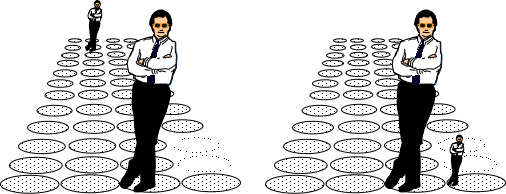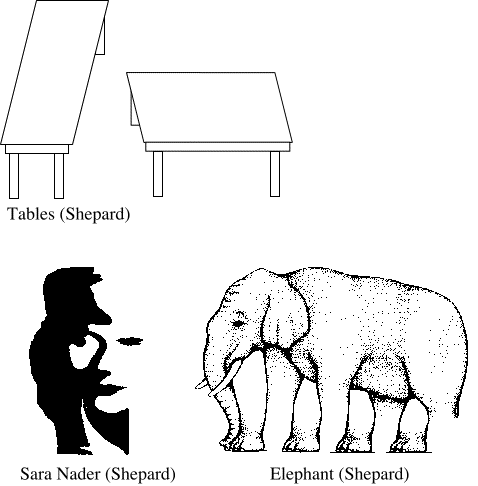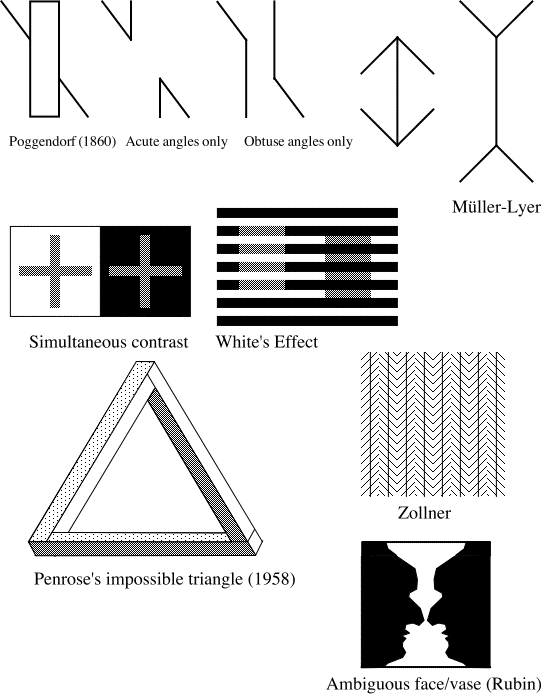
Figure 1 Illusion of size
A hallucination is a false perception seen by one person, often drugged or mentally ill, in the absence of stimulation, whereas an illusion is a misinterpretation of a stimulus consistently experienced by most normal people. Illusions are characteristic errors of the visual system that may give us clues to underlying mechanisms. There are several types of visual illusion:
Angles: In the Zollner and Hering (1861) illusions, the long parallel lines appear to be tilted away from the orientation of the background fins (figure 1). Blakemore (1973) attributes this to "tilt contrast," caused by lateral inhibition between neural signals of orientation, which will expand the appearance of acute angles. This theory has problems with the Poggendorff (1860) illusion, which still persists when only the obtuse angles are present, but vanishes when only the acute angles are present (see Burmester 1986). In Fraser's (1908) twisted-rope spiral illusion, the circles look like spirals because of the twisted local ropes, abetted by the diamonds in the background. The visual system seems to take "local votes" of orientation and fails to integrate them correctly.

Figure 1 Illusion of size
Size: Gregory points out that size constancy scaling allows the correct perception of the size of objects even when their distance, and hence retinal size, changes. He attributes the geometrical illusions of size to an inappropriate application of size constancy. Thus the nearby man in figure 1 looks tiny compared to the distant man, even though the retinal sizes are identical: depth cues from the ground plane allow size constancy perceptually to expand distant objects. More subtly, in the Muller Lyer illusion, the arrow fins provide cues similar to those from receding and advancing corners, and in Roger Shepard's table illusion (figure 2, top), the two table tops are geometrically identical on the page but look like completely different 3-D shapes, because size and shape constancy subjectively expand the near-far dimension along the line of sight to compensate for geometrical foreshortening.
A gray cross looks darker on a white than on a black surround. On a red surround it looks greenish, probably owing to lateral inhibition from neurons that sense the white or colored surround. In White's illusion, the grey segments that replace black bars are bordered by much white above and below, so they "ought" to look darker than the gray segments that replace white bars. But in fact they look lighter. This might show that lateral inhibition operates more strongly along the bars than across them, but more likely it is a top-down "belongingness" effect based on colinearity.
In ambiguous pictures, the brain switches between two possible figure-ground interpretations -- in figure 3, faces and a vase -- even though the stimulus does not change. The shape of the region selected as figure is perceived and remembered; that of the ground is not.
Impossible figures embody conflicting 3-D cues. Penrose's "impossible triangle" (figure 3) is not the projection of any possible physical object. It holds together by means of incorrect connections between its corners, which are correct locally but incorrect globally. Shepard's elephant (figure 2) confuses its legs with the spaces in between. Local votes about depth are not properly integrated. Impossible objects cannot be consistently painted with colors.
In puzzle pictures there is one possible interpretation, but reduced cues make it hard to find. (Shepard's Sara Nader, figure 2, is unusual in having two different possibilities). Once found, immediate perceptual learning makes the picture easier to remember, and immediately recognizable the next time it is seen.

Figure 2 Top: Illusion of size; Bottom: Illusions of interpretation.
The Belgian surrealist painter René Magritte (1898-1967) and the Dutch engraver Maurits Escher (1898 - 1972) filled their works with splendid visual illusions (http://www.bright-ideas.com/magrittegallery/aF.html and http://www.worldofescher.com/). Collections of illusions can be seen on CD-ROM (Scientific American) and on Al Seckel's Web page at http://www.lainet.com/illusions/.

Figure 3 Top: Illusions of angle and size; Middle: Illusions of lightness and color; Bottom: Illusions of interpretation.
Blakemore, C. B. (1973). The baffled brain. In R. L. Gregory and E. H. Gombrich, Eds., Illusion in Nature and Art. London: Duckworth.
Block, J. R., and H. Yuker. (1992) Can You Believe Your Eyes? Brunner/Mazel.
Burmester, E. (1986). Beitrag zur experimentellen Bestimmung geometricsh - optischen. Z. Psychol. 12: 355
Ernst, B. (1985). The Magic Mirror of M. C. Escher. Stradbroke, England: Tarquin.
Fraser, J. (1908). A new illusion of directing. British Journal of Psychology 2, 307-320.
Gregory, R. L. (1974). Concepts and Mechanisms of Perception. London: Duckworth.
Robinson, J. (1971). The Psychology of Visual Illusions. London: Hutchinson.
Rock, I., and D. H. Hubel. (1997). Illusion (CD-ROM). Scientific American Library. Simon and Schuster/Byron Preiss Multimedia.
Shepard, R. N. (1990). Mindsights. New York: Freeman.
Wade, N. (1982) The Art and Science of Visual Illusions. London: Routledge and Kegan Paul.